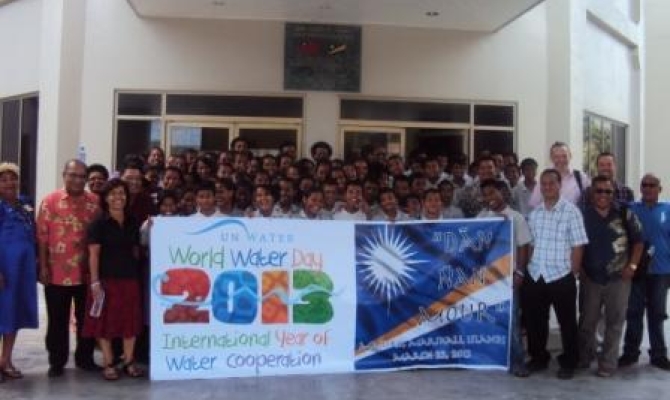
Climate Change Resilience
As the world observes World Water Day on 21 March this year, six projects under the Pacific Adaptation to Climate Change (PACC) programme have their own good reasons for celebrating. Each has contributed to major improvements in their nation’s water management, making their communities much more resilient to the future climate.
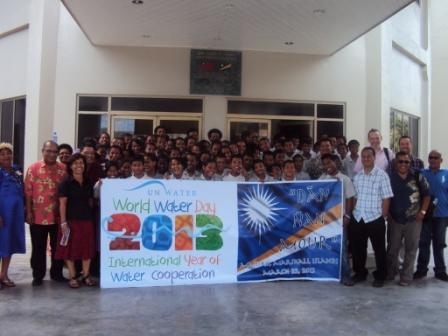 “The six countries – Marshall Islands, Nauru, Niue, Tokelau, Tonga and Tuvalu – all identified water as a priority issue at the start of the PACC programme in 2009,” said PACC Programme Officer, Peni Leavai. “These small islands all rely heavily on rainfall for their freshwater, and have been experiencing problems as rainfall patterns change. Under PACC, they have been trialling diverse options to address this.”
“The six countries – Marshall Islands, Nauru, Niue, Tokelau, Tonga and Tuvalu – all identified water as a priority issue at the start of the PACC programme in 2009,” said PACC Programme Officer, Peni Leavai. “These small islands all rely heavily on rainfall for their freshwater, and have been experiencing problems as rainfall patterns change. Under PACC, they have been trialling diverse options to address this.”
The six projects have made some very practical advances towards national water security; at the same time, they have contributed to policy frameworks that make their water sectors more resilient to climate change. Now in their final year, this is a timely opportunity to briefly outline some of the stories and achievements from these PACC projects.
Photo: RMI PACC project - Celebrating World Water day last year in the Marshall Islands.
A new reservoir for the Marshall Islands
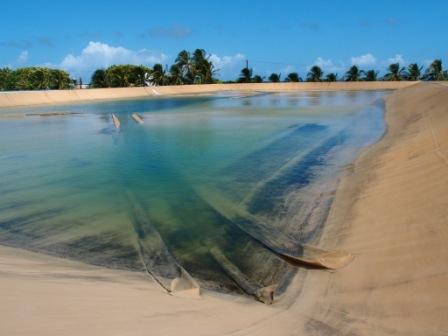 In the Marshall Islands, a nation of low-lying atolls, the PACC project is improving the water catchment and reservoir system on the main island of Majuro. The densely populated island makes the most of its largest paved area – the airport runway – to collect rainwater, and then diverts it to a storage reservoir where it is treated and piped to communities. However, increasing population (currently about 28,000) and outdated infrastructure, compounded by unpredictable and often challenging weather, meant that the system was becoming inadequate. PACC project activities have focused on renovating the reservoir, including relining and installing a cover to reduce evaporation. The improved reservoir will be officially opened during the first week April.
In the Marshall Islands, a nation of low-lying atolls, the PACC project is improving the water catchment and reservoir system on the main island of Majuro. The densely populated island makes the most of its largest paved area – the airport runway – to collect rainwater, and then diverts it to a storage reservoir where it is treated and piped to communities. However, increasing population (currently about 28,000) and outdated infrastructure, compounded by unpredictable and often challenging weather, meant that the system was becoming inadequate. PACC project activities have focused on renovating the reservoir, including relining and installing a cover to reduce evaporation. The improved reservoir will be officially opened during the first week April.
Photo: RMI PACC project - Relining the reservoir at Majuro.
Water from the sun in Nauru
Nauru is a single island well known for its phosphate deposits. Less well known is the challenge faced by the more than 9,000 inhabitants in supplying their everyday water needs. Nauruans mainly rely on groundwater, but this has become increasingly polluted and contaminated with saltwater.
While Nauru is short on freshwater, it has plenty of sunshine. Exploiting this, the PACC project introduced a new technology to the island – solar-powered water purifiers – which convert contaminated water into clean drinking water. As a demonstration, the project installed 36 purifier units in two communities, each one capable of producing more than 20 litres of potable water per day. The pilot was a success, and the technology is now expanding across the island – and beyond. The Marshall Islands PACC team recognised the potential of this technology for their remote outer islands, and an order of solar purifiers is currently in transit, to be deployed in schools and hospitals in the first instance.
Niue becomes self-sufficient in rainwater tanks
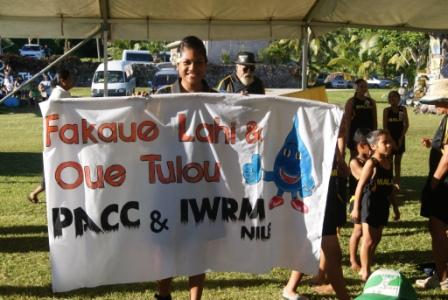 Niue is another single-island nation that depends on rainwater, with most of the 430 households responsible for collecting and storing their own water. However, the cost of importing water tanks from New Zealand, combined with poor maintenance of guttering and pipes, was leading to inefficient systems and a looming crisis. Niue’s solution – to build a tank-moulding facility and produce its own water tanks at about half the price, and at the same time carry out a national awareness campaign on maintaining these systems, pipes and fittings. The workshop opened in late 2013, and the locally made water tanks are currently being installed around the island, with a goal of 100% of households having new tanks and updated systems by the end of 2014.
Niue is another single-island nation that depends on rainwater, with most of the 430 households responsible for collecting and storing their own water. However, the cost of importing water tanks from New Zealand, combined with poor maintenance of guttering and pipes, was leading to inefficient systems and a looming crisis. Niue’s solution – to build a tank-moulding facility and produce its own water tanks at about half the price, and at the same time carry out a national awareness campaign on maintaining these systems, pipes and fittings. The workshop opened in late 2013, and the locally made water tanks are currently being installed around the island, with a goal of 100% of households having new tanks and updated systems by the end of 2014.
Photo - Niue PACC Project
Upgraded water systems for Tokelau, Tonga and Tuvalu
Not all of the PACC solutions involve introducing new technologies. For several projects, it has been a case of restoring and upgrading basic household and community water systems, such as guttering, downpipes and water tanks. “Often something as simple as reducing leaks can mean a major improvement in water security,” says Mr Leavai. “More efficient systems, with water pumps and the right sized tanks, can also make a big difference.”
Two communities on Funafuti atoll in Tuvalu can attest to this. Large-capacity cisterns, holding 700,000 and 288,000 litres, have been installed at Lofeagai and Kavatoetoe, respectively. These offer critical backup for times of prolonged drought, as well as providing for the day-to-day water needs of the 83 (Lofeagai) and 108 (Kavatoetoe) households.
Hihifo district on Tongatapu in the Kingdom of Tonga is also benefiting from new water storage equipment – three 45,000 litre water tanks, one overhead 22,500 litre tank and 30 smaller tanks that hold 10,000 litres each have all been installed over the last year, with more than 400 households benefiting. And in Tokelau, communities on all three atolls are having their systems improved with new guttering and flush diverters that provide cleaner water.
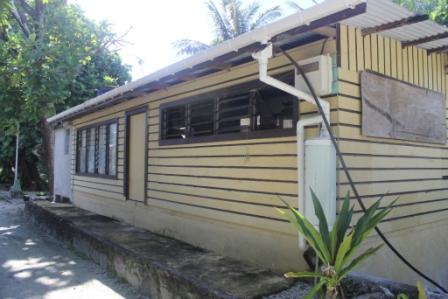
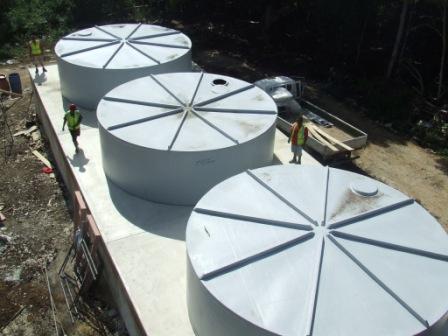
Left: New guttering and flush diverter in Tokelau. Photo: Tokelau PACC project.
Right: New water tanks in Tonga. Photo: Tonga PACC project.
All six countries will be holding World Water Day celebrations this week, and achievements under the PACC programme will be high on the agenda. The climate may be uncertain, but with improved water systems in place, each of these countries can expect a more secure future.
 “The six countries – Marshall Islands, Nauru, Niue, Tokelau, Tonga and Tuvalu – all identified water as a priority issue at the start of the PACC programme in 2009,” said PACC Programme Officer, Peni Leavai. “These small islands all rely heavily on rainfall for their freshwater, and have been experiencing problems as rainfall patterns change. Under PACC, they have been trialling diverse options to address this.”
“The six countries – Marshall Islands, Nauru, Niue, Tokelau, Tonga and Tuvalu – all identified water as a priority issue at the start of the PACC programme in 2009,” said PACC Programme Officer, Peni Leavai. “These small islands all rely heavily on rainfall for their freshwater, and have been experiencing problems as rainfall patterns change. Under PACC, they have been trialling diverse options to address this.”The six projects have made some very practical advances towards national water security; at the same time, they have contributed to policy frameworks that make their water sectors more resilient to climate change. Now in their final year, this is a timely opportunity to briefly outline some of the stories and achievements from these PACC projects.
Photo: RMI PACC project - Celebrating World Water day last year in the Marshall Islands.
A new reservoir for the Marshall Islands
 In the Marshall Islands, a nation of low-lying atolls, the PACC project is improving the water catchment and reservoir system on the main island of Majuro. The densely populated island makes the most of its largest paved area – the airport runway – to collect rainwater, and then diverts it to a storage reservoir where it is treated and piped to communities. However, increasing population (currently about 28,000) and outdated infrastructure, compounded by unpredictable and often challenging weather, meant that the system was becoming inadequate. PACC project activities have focused on renovating the reservoir, including relining and installing a cover to reduce evaporation. The improved reservoir will be officially opened during the first week April.
In the Marshall Islands, a nation of low-lying atolls, the PACC project is improving the water catchment and reservoir system on the main island of Majuro. The densely populated island makes the most of its largest paved area – the airport runway – to collect rainwater, and then diverts it to a storage reservoir where it is treated and piped to communities. However, increasing population (currently about 28,000) and outdated infrastructure, compounded by unpredictable and often challenging weather, meant that the system was becoming inadequate. PACC project activities have focused on renovating the reservoir, including relining and installing a cover to reduce evaporation. The improved reservoir will be officially opened during the first week April.Photo: RMI PACC project - Relining the reservoir at Majuro.
Water from the sun in Nauru
Nauru is a single island well known for its phosphate deposits. Less well known is the challenge faced by the more than 9,000 inhabitants in supplying their everyday water needs. Nauruans mainly rely on groundwater, but this has become increasingly polluted and contaminated with saltwater.
While Nauru is short on freshwater, it has plenty of sunshine. Exploiting this, the PACC project introduced a new technology to the island – solar-powered water purifiers – which convert contaminated water into clean drinking water. As a demonstration, the project installed 36 purifier units in two communities, each one capable of producing more than 20 litres of potable water per day. The pilot was a success, and the technology is now expanding across the island – and beyond. The Marshall Islands PACC team recognised the potential of this technology for their remote outer islands, and an order of solar purifiers is currently in transit, to be deployed in schools and hospitals in the first instance.
Niue becomes self-sufficient in rainwater tanks
 Niue is another single-island nation that depends on rainwater, with most of the 430 households responsible for collecting and storing their own water. However, the cost of importing water tanks from New Zealand, combined with poor maintenance of guttering and pipes, was leading to inefficient systems and a looming crisis. Niue’s solution – to build a tank-moulding facility and produce its own water tanks at about half the price, and at the same time carry out a national awareness campaign on maintaining these systems, pipes and fittings. The workshop opened in late 2013, and the locally made water tanks are currently being installed around the island, with a goal of 100% of households having new tanks and updated systems by the end of 2014.
Niue is another single-island nation that depends on rainwater, with most of the 430 households responsible for collecting and storing their own water. However, the cost of importing water tanks from New Zealand, combined with poor maintenance of guttering and pipes, was leading to inefficient systems and a looming crisis. Niue’s solution – to build a tank-moulding facility and produce its own water tanks at about half the price, and at the same time carry out a national awareness campaign on maintaining these systems, pipes and fittings. The workshop opened in late 2013, and the locally made water tanks are currently being installed around the island, with a goal of 100% of households having new tanks and updated systems by the end of 2014.Photo - Niue PACC Project
Upgraded water systems for Tokelau, Tonga and Tuvalu
Not all of the PACC solutions involve introducing new technologies. For several projects, it has been a case of restoring and upgrading basic household and community water systems, such as guttering, downpipes and water tanks. “Often something as simple as reducing leaks can mean a major improvement in water security,” says Mr Leavai. “More efficient systems, with water pumps and the right sized tanks, can also make a big difference.”
Two communities on Funafuti atoll in Tuvalu can attest to this. Large-capacity cisterns, holding 700,000 and 288,000 litres, have been installed at Lofeagai and Kavatoetoe, respectively. These offer critical backup for times of prolonged drought, as well as providing for the day-to-day water needs of the 83 (Lofeagai) and 108 (Kavatoetoe) households.
Hihifo district on Tongatapu in the Kingdom of Tonga is also benefiting from new water storage equipment – three 45,000 litre water tanks, one overhead 22,500 litre tank and 30 smaller tanks that hold 10,000 litres each have all been installed over the last year, with more than 400 households benefiting. And in Tokelau, communities on all three atolls are having their systems improved with new guttering and flush diverters that provide cleaner water.


Left: New guttering and flush diverter in Tokelau. Photo: Tokelau PACC project.
Right: New water tanks in Tonga. Photo: Tonga PACC project.
All six countries will be holding World Water Day celebrations this week, and achievements under the PACC programme will be high on the agenda. The climate may be uncertain, but with improved water systems in place, each of these countries can expect a more secure future.